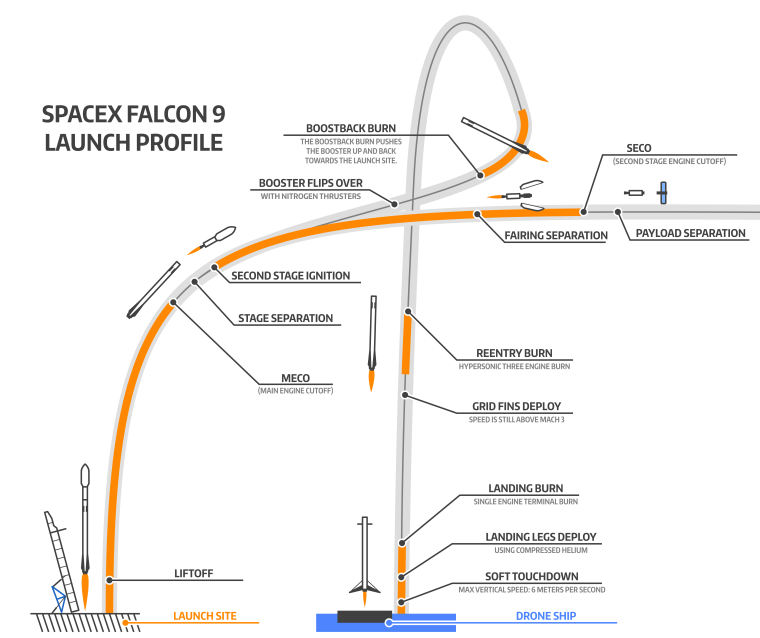CAPE CANAVERAL, Fla. — A last-minute problem with a single actuator forced a postponement of SpaceX's attempt to launch a Falcon 9 launch vehicle carrying cargo to the International Space Station on Tuesday — and make a historic rocket landing in the process.
The landing experiment would have involved bringing the first stage of the two-stage rocket down onto a floating platform in the Atlantic Ocean, about 200 miles off the coast of Florida. Such a feat has never been done before. A successful maneuver would have marked a significant step toward making rockets more reusable and driving down the cost of spaceflight.
Even SpaceX recognized that the rocket stage landing, which was due to take place minutes after launch from Cape Canaveral Air Force Station in Florida, was not the mission's main objective.
"The main mission is absolutely to get cargo to the station," Hans Koenigsmann, vice president of mission assurance at the California-based rocket company, told reporters during a pre-launch briefing at NASA's Kennedy Space Center.
Liftoff was aborted with less than a minute and a half left in the countdown. NASA commentator George Diller said the launch team identified a problem with actuator drift, affecting a control the second stage's rocket engine thrust.
"During the terminal count, engineers observed drift on one of the two thrust vector actuators on the second stage that would likely have caused an automatic abort," SpaceX spokesman John Taylor said in a statement. "Engineers called a hold in order to take a closer look."
The next launch opportunity comes at 5:09 a.m. ET Friday, with NASA TV coverage beginning at 4:15 a.m. ET. Forecasters said there was a 70 percent chance of acceptable weather for launch.
Important supply run
This is SpaceX's fifth resupply mission under the terms of a $1.6 billion contract with NASA that covers 12 flights in all. The cargo run is particularly important in the wake of October's blow-up of Orbital Sciences Corp.'s Antares rocket, which was supposed to send a Cygnus cargo capsule to the space station. Some payloads have been shifted to SpaceX's Dragon to make up for that loss.
Among the more than 5,200 pounds of supplies and equipment that have been packed aboard this Dragon are duplicates of 17 student experiments that were on the ill-fated Cygnus. The science payloads also include an experiment to study the immune systems of fruit flies and the wound-healing capabilities of flatworms in the space environment.
One of the most important payloads is a laser remote-sensing experiment that will monitor the worldwide distribution of clouds and aerosols from orbit. The $15 million Cloud-Aerosol Transport System, or CATS, is due to be set up on the space station's exterior later this month.
Julie Robinson, NASA's chief scientist for the space station program, said such studies fit the station's scientific role of being "off the Earth, for the Earth."
The Dragon also carries more mundane supplies, such as the food, water and clothing needed by the space station's six residents.
Historic experiment
As long as the rocket gets SpaceX's Dragon into the proper orbit for its hookup, the launch will be judged a success from NASA's point of view. But SpaceX and its billionaire founder, Elon Musk, are hoping for something more: the success of a maneuver that could make spaceflight far more affordable in the future.
The new twist comes after the Falcon 9's first stage finishes its main job. Three minutes after launch, the second stage is due to separate and fire up its own rocket engine to continue the trip. Then the first stage is slated to relight its rocket engines and go through a complex series of maneuvers to put itself safely down on a 300-foot-long, 170-foot-wide "autonomous spaceport drone ship" in the Atlantic.
SpaceX has tested aspects of the maneuver before, resulting in a soft splashdowns, but this will be the first time the company tries setting the rocket stage down on a platform for retrieval and return to port. The maneuver will be facilitated by precision firing of the Falcon 9's nine first-stage engines, as well as contributions from four hypersonic stabilizing fins and landing legs.

For a larger version of the graphic and a full explanation of the launch profile and its significance, check out 'The Future of Space Launch Is Near' by John Gardi and Jon Ross.
The drone ship is equipped with underwater thrusters to compensate for the pitch and roll of the sea; nevertheless, SpaceX acknowledges that the maneuver may not work.
"When you look at it on the ground, I think it's probably a very, very big platform, a big spaceport," Koenigsmann said. "But if you look at it from, I think, almost 150 or so miles up in suborbit, then it looks like a very, very small place to land on."
Musk has said the chances of success were 50-50 at most, but during a Reddit chat session on Monday night, he confessed that he really didn't know what the odds were. "I pretty much made that up," he said.
It may take hours to determine whether the drone ship landing succeeded, Koenigsmann said, due to the uncertainties surrounding data connectivity in the Atlantic. Even if this first attempt fails, Musk intends to keep testing the landing procedure: It's a key element in his plan to make rockets more reusable and spaceflight more affordable, with the eventual goal of sending colonists to Mars.